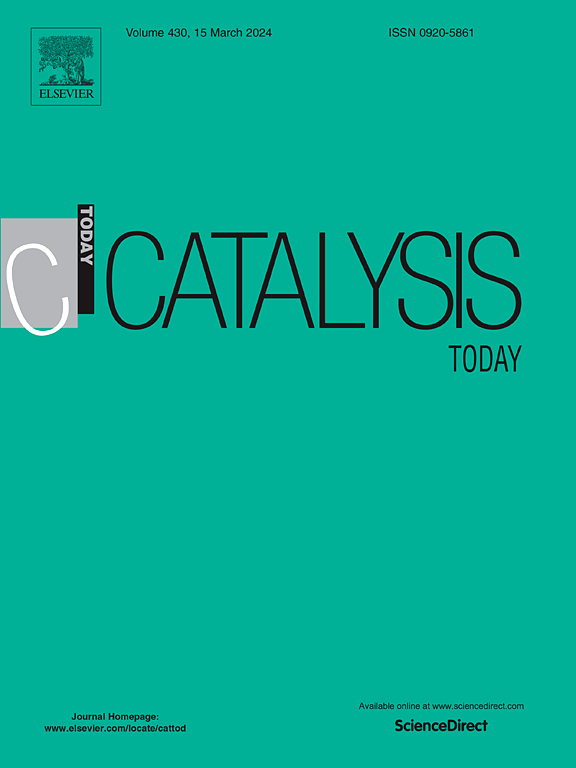Optimizing propylene production via acetone hydrodeoxygenation: Insights from catalytic studies with Cu/γ-Al2O3 and Hβ zeolite
IF 5.3
2区 化学
Q1 CHEMISTRY, APPLIED
引用次数: 0
Abstract
Propylene is a crucial light olefin in the petrochemical industry and can be produced via acetone hydrodeoxygenation, which involves two sequential reactions: first, acetone undergoes hydrogenation catalyzed by metallic sites, followed by the dehydration of the resulting isopropanol catalyzed by acidic sites. In this study, propylene production through acetone hydrodeoxygenation was investigated using a physical mixture of 35 wt% Cu/γ-Al2O3 and Hβ zeolite to investigate how various reaction parameters affect acetone conversion and propylene yield. Using the experimental design methodology, empirical models were developed to correlate acetone conversion () and propylene yield with the ratio of 35 wt% Cu/γ-Al2O3 to Hβ (CR), total catalyst weight (Cw), hydrogen volumetric flow rate (FH2) and reaction temperature (T). The maximum propylene yield achieved in the catalytic tests was 73.46 %. A long-term test demonstrated the catalyst's reusability, remaining active even after 22 hours of reaction with only a slight decrease in propylene yield. Analysis of the experimental data revealed that increasing T and Cw positively affected propylene yield, whereas higher CR and FH2 had negative effects. According to the Pareto chart, reaction temperature was the most influential variable for propylene yield, followed by CR, FH2 and Cw. For acetone conversion, the order of significance among the variables was T > CR > Cw > FH2.
通过丙酮加氢脱氧优化丙烯生产:使用 Cu/γ-Al2O3 和 Hβ 沸石进行催化研究的启示
丙烯是石化工业中一种重要的轻质烯烃,可通过丙酮加氢脱氧反应生产,其中包括两个连续反应:首先,丙酮在金属位点的催化下发生加氢反应,然后在酸性位点的催化下使生成的异丙醇脱水。本研究使用 35 wt% Cu/γ-Al2O3 和 Hβ 沸石的物理混合物研究了丙酮加氢脱氧生成丙烯的过程,探讨了各种反应参数对丙酮转化率和丙烯产量的影响。利用实验设计方法,建立了丙酮转化率 (Xacet) 和丙烯产率 (Yprop) 与 35 wt% Cu/γ-Al2O3 与 Hβ 的比率 (CR)、催化剂总重量 (Cw)、氢气体积流量 (FH2) 和反应温度 (T) 的经验模型。催化试验中达到的最大丙烯产率为 73.46%。一项长期测试证明了催化剂的可重复使用性,即使在反应 22 小时后,催化剂仍能保持活性,丙烯产率仅略有下降。对实验数据的分析表明,T 和 Cw 的增加对丙烯产量有积极影响,而 CR 和 FH2 的增加则有消极影响。根据帕累托图表,反应温度是对丙烯产量影响最大的变量,其次是 CR、FH2 和 Cw。就丙酮转化率而言,各变量之间的显著性顺序为 T > CR > Cw > FH2。
本文章由计算机程序翻译,如有差异,请以英文原文为准。
求助全文
约1分钟内获得全文
求助全文
来源期刊

Catalysis Today
化学-工程:化工
CiteScore
11.50
自引率
3.80%
发文量
573
审稿时长
2.9 months
期刊介绍:
Catalysis Today focuses on the rapid publication of original invited papers devoted to currently important topics in catalysis and related subjects. The journal only publishes special issues (Proposing a Catalysis Today Special Issue), each of which is supervised by Guest Editors who recruit individual papers and oversee the peer review process. Catalysis Today offers researchers in the field of catalysis in-depth overviews of topical issues.
Both fundamental and applied aspects of catalysis are covered. Subjects such as catalysis of immobilized organometallic and biocatalytic systems are welcome. Subjects related to catalysis such as experimental techniques, adsorption, process technology, synthesis, in situ characterization, computational, theoretical modeling, imaging and others are included if there is a clear relationship to catalysis.
 求助内容:
求助内容: 应助结果提醒方式:
应助结果提醒方式:


